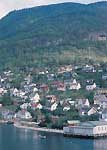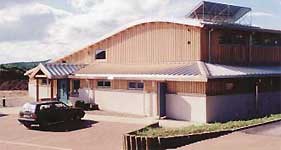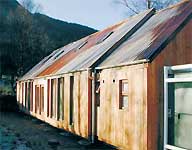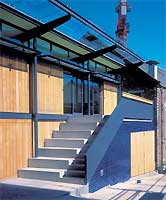Timber cladding in Scotland
The study outlines the development of timber cladding in Scotland, describes timber clad buildings in Scotland, and provides practical information on the use of timber cladding in Scotland.
Timber Cladding in Scotland
BUILDING CONTROL
Building control in Scotland has existed since around AD 1119 (13) and the legislation, now as then, sets the minimum acceptable technical standard for construction work. Under modern regulations, a building's design must demonstrate fitness for purpose and, in the case of external timber cladding, has to demonstrate that it is sufficiently durable for its intended service life and that it will perform satisfactorily in a fire. Building Control Officers seek good design and detailing to achieve these aims and are generally sympathetic to the use of external timber cladding providing these technical issues are properly addressed. Compliance with the Scottish Building Regulations is achievable in several ways, depending upon the particular building design or product being proposed (10):
- By meeting the requirements of the relevant British Standards or equivalent standards of another member state of the European Union;
- By AgrÈment Certificate coverage or equivalent approval issued in any member state of the European Union;
- By meeting the requirements of a technical approval issued under the European Construction Products Directive;
- With test evidence from an accredited laboratory;
- With evidence of a material's satisfactory performance in similar environmental conditions;
- By compliance with an EC Directive.
No Building Control Officer is likely be familiar with how these compliance mechanisms affect every material in every instance, and there may be occasions where the compliance process is protracted.
The Scottish Building Regulations differ in important respects from those in England and Wales, but since much of the available technical guidance is produced for England there are sometimes discrepancies between designs proposed and the recommendations of Building Control Officers in Scotland.
DEVELOPERS
Some developers privately recognise that moving to lightweight structures and cladding is desirable, but this is only slowly being translated into building practice. This may be because developers are risk averse when it comes to design and have very limited capacity for in-house design and innovation. It could also be that some developers consider timber cladding a potential impediment to securing planning approval and, because delay in obtaining permission can result in significant additional costs, they prefer masonry cladding. Because they are reluctant to experiment with their own product, more demonstration projects could help to influence developers.
MORTGAGE PROVIDERS
Difficulties in obtaining mortgages for timber-clad, or in some cases, timber-framed homes existed in the 1970's and '80's, but in the past decade this problem has largely disappeared. There now appears to be little difficulty in securing a mortgage on a timber-clad house, with High Street lenders such as the Halifax 'lending on the person not the product'. A cause of some concern, however, is the policy of two well known lenders who have recently published guidelines indicating that they will not lend on timber-framed, timber-clad houses.
CLADDING SUPPLIERS
Construction industry buyers seek consistency in supply and well-informed technical support from suppliers (11) - basic market requirements sometimes missing in the case of timber cladding. External cladding production in Scotland is currently restricted to sawing and/or machining of imported timbers, usually by large specialised sawmills linked to importers or the small-scale sawing and machining of home-grown timber cladding - usually by small sawmills. Generally, the quality, drying and machining of the timber cladding produced by importers is good. Unfortunately, the same cannot be said of smaller Scottish suppliers where - in some cases - standards of timber grading, drying and processing require improvement. Similarly, considerable variation exists in the quality of technical support available from suppliers.
PUBLIC AND PRIVATE OWNERS
Maintenance costs are a key issue affecting most public and private property owners. Minimising expenditure is a natural concern of owners everywhere, but low maintenance seems to be a peculiarly British pre-occupation - in Scandinavia regular paint maintenance is regarded as an opportunity to freshen-up house exteriors every ten years whereas in Scotland the cost of the same task is often seen as prohibitive. The perception of high maintenance costs are undoubtedly a significant barrier to greater acceptance of timber cladding in Scotland and this is true for both individual homeowners and for housing associations. Sometimes, however, these difficulties disappear - some private clients accepting the need for regular maintenance and, in the case of Hjlatland Housing Association in Shetland, painted timber cladding is used because no cost-effective alternative exists (the local stone offering only poor quality aggregate for breeze blocks). These are exceptions, however, and several stakeholders believe a substantial design and marketing push is required for external timber cladding to gain wider consumer acceptance in Scotland.

|
|
In Scandinavia regular paint maintenance is regarded as an opportunity to freshen up house exteriors. |
Locally-grown western red cedar cladding was used on the Ardross Millennium Project, near Alness by David Somerville Architect. |
SUSTAINABILITY AS A MARKET DRIVER
Sustainability is one of the most important factors driving the recent market growth for timber cladding in Scotland, but a wide variation in the understanding of this issue makes for even greater diversity in its practical application. Interest in sustainability is growing in Scotland because of increasing environmental concerns amongst some specifiers and clients, reinforced by recent published guidance from Scottish Homes and the Scottish Executive (9, 12). The impact of Landfill Tax is also increasing demand for long-life, repairable products, or for materials which on disposal will not be classed as toxic waste.
In practice, sustainability is often sacrificed in the face of the severe cost pressures which affect much commercial development. People are frequently prepared to pay a slight premium for products such as safe food, but there is little evidence in the construction market of either an environmental or a Scottish (i.e. local) premium. Customers will, however, favour environmentally-sound or locally-sourced products if their price and quality match existing ones, and a potential market-share advantage is available to those environmentally-sound and/or local producers capable of capitalising on this (13). To do so, however, specific issues need to be addressed:
1 ENVIRONMENTAL SOUNDNESS
Assessing the possible environmental impacts of a building material during its complete life cycle from raw material sourcing through to its eventual, re-use, recycling or disposal is known as life cycle analysis (LCA). In the context of timber cladding, this includes:
- Raw material sourcing -
the production of timber as a raw material is a woodland management issue and LCA's require evidence of sustainable management; - Embodied energy -
the energy consumed in transporting and processing raw material and timber products (the embodied energy) can be quantified and compared with other products; - Wood preservation and other chemical additives -
many preservatives, glues and coatings may have adverse environmental impacts associated with their manufacture and use. Their presence in a timber cladding product can limit the options for the material's re-use, recycling or disposal.
|
2 LOCAL SOURCING Buying products that have been manufactured locally minimises the energy consumed in transportation, and helps sustain local economies and cultures. However, the definition of what constitutes local can vary enormously because the availability of materials and manufacturers is not uniform - a wide range of locally-made products can be found in large cities whereas in some parts of the Scottish Highlands the nearest manufacturer of certain building products may be hundreds of miles away. Local sourcing is therefore a four stage process: regional; Scottish; European; global, but two additional factors can limit its applicability:
|
New publicly funded buildings are increasingly emphasising sustainability. This new visitor centre at Glencoe by Gaia Architects avoids the use of timber preservatives and sources all of its timber in Scotland. |
- Conventional supply contracts -
In an international market place affected by fluctuating foreign exchange rates and other variables, local timber products may not be as competitive as imports, and have cost penalties which may be resisted by contractors and quantity surveyors responsible for the procurement of construction products. Such resistance inevitably results from the way in which many conventional construction industry supply-chains are structured - to secure best value, contracts between clients and main contractors are often arranged by competitive tender with several firms competing against each other on price. Although architects and clients may advocate local sourcing, they are not in reality the people who can deliver it. As the main links in the supply chain, suppliers and subcontractors to the main building contractor are the ones who can actually deliver local sourcing but - with huge pressure to reduce costs - they have the least personal interest in the issue. This problem may be reduced or avoided by current trends towards supply chain partnerships on large contracts, but such arrangements still rarely apply to smaller contracts.
Sourcing of timber in Scotland has to date been most successful in situations where local products are able to compete on cost or performance against imports or where the person paying for the building is committed to using specific products and either stipulates their use or purchases them direct from suppliers. Alternative structures to conventional supply chains need developing, e.g. within design-build companies or the self-build sector (11).
FUTURE OPPORTUNITIES
With timber cladding now achieving respectability in Scotland and able to compete on its merits against other external cladding materials, two major opportunities exist for its future development:
- Increased use of lightweight timbercladding on housing -
Timber cladding offers cost, performance and sustainability benefits, particularly when used in combination with lightweight roof coverings and structural systems to form integrated, energy-conscious designs. These benefits are equally relevant to private housebuilders, developers and housing associations. - Increased use of timber as a high status cladding material -
Timber cladding can compete on cost, performance, and sustainability grounds in large budget architectural schemes. It is a viable - and desirable - alternative to other prestigious cladding materials (e.g. pre-cast concrete, stone, stainless steel or glazed brick) and can co-exist alongside other claddings. Properly promoted, this use of timber could prove attractive to architects and their clients, particularly in the leisure, commercial, and public building sector and for architect-designed private housing.
Unfortunately there is no quantified research available on emerging market niches for timber cladding in Scotland and gathering such information would be very beneficial.
Suppliers of timber cladding - particularly home-grown - need to provide the level of information, technical support, product quality and consistency that customers expect. One solution is to establish a timber cladding association able to set minimum quality standards and provide technical assistance to customers. The Lead Contractors' Association is a useful model: industry funded, it provides high-quality technical information and has set demanding quality targets as a condition of membership (14). By aiming high, it has succeeded in gaining widespread industry trust to the extent that some building contracts are now open only to members of the association. To be successful, a UK timber cladding association would require similarly high standards.
Producers could also benefit from research into timber cladding made from Scottish oak, including designs utilising shingles and short board lengths of 'green oak'. A market opportunity may also exist for the large softwood sawmilling sector to supply Scots pine, spruce or other homegrown softwood timber cladding, and more research into the suitability of these species is required as well as into the application of defect cutting technology.
|
Industry-led marketing and promotion could also be helpful in:
|
Scottish Poetry Library by Malcolm Fraser Architects uses uncoated European oak in its sliding screens and doors. |
In addition to industry-led initiatives there are opportunities where other key stakeholders could assist the development of timber cladding in Scotland:
POLICY MAKERS
As climate change reduction measures assume ever greater importance in Scotland, the role of lightweight cladding systems looks set to grow as a part of the search for energy-efficient and cost-effective building design. Unlike Canada and Norway, there is limited information available in Scotland on timber cladding in exposed maritime conditions. What is published tends to be written mainly for the UK's southern climatic conditions, and contains standard details which do not comply with Scottish requirements. In some cases this results in the use of inappropriate details, and technical guidance on timber cladding specifically focused on Scottish conditions and the Scottish Building Regulations is needed.
Best practice in timber cladding specification may not be fully reflected in current British Standards and a specific British Standard for external timber cladding is needed. The National Building Specification for timber weatherboarding would also benefit from revision and expansion to reflect current best practice.
There could be benefits for sustainability if European Procurement Rules were modified to enable greater local sourcing of building products.
Key stakeholders such as planning and building control officers, architects, developers and suppliers need more opportunities for open and positive dialogue on timber cladding. In controlled conditions, demonstration projects can promote building innovation in timber-clad housing, particularly where affordable and energy-efficient designs suitable for developers and social housing providers are explored.
ARCHITECTS AND OTHER BUILDING DESIGNERS
Although currently producing attractive and original designs using timber cladding, Scottish architects need more information on the subject via seminars, Continuing Professional Development programmes and publications since variable detailing standards are apparent in the use of what is still a relatively unfamiliar and quite specialised product.
ARCHAEOLOGISTS AND BUILDING HISTORIANS
Considerable evidence exists for the historical use of timber cladding in Scotland, yet little information has been recorded, analysed or published. Current practice could be informed by more research into, for example, the impact of early fire control legislation in the royal burghs, the evolution of the Scottish timber trade, and the development of 19th century timber cladding in Scotland.
RESEARCH AND TECHNOLOGY ORGANISATIONS
A wide range of historical timber cladding survives around Scotland. These buildings provide a resource which can help in the assessment of timber cladding's expected service life when used in similar situations today, and greater use could be made of this empirical evidence.
The growth of interest in cladding has highlighted uncertainties in the choice and specification of external cladding timber which could, if the wrong choices are made, give rise to building envelope failures. Further research is needed into these issues. For example, the transferability of cladding designs from sheltered to exposed maritime climates raises a number of uncertainties. Scotland-specific research and publication of such information would be useful but, at the very least, any UK-wide detailing guidance should include detailing examples for the full range of climate exposure classes (this is already provided for some other cladding materials but not for timber). Similarly, the suitability of open-joined timber cladding designs for exposed sites has been questioned and in-situ performance monitoring of a representative sample of designs already built would be beneficial.
SOCIAL HOUSING PROVIDERS
For local sourcing of timber cladding to become significant in Scotland, more focus needs to be placed on the structure of the timber supply chain and on alternative models such as design-build. And, given the evident enthusiasm amongst housing associations and some local authorities for sustainable-building measures, further discussion, demonstrations and exchanges of good-practice using timber cladding as a model are required.
References
1 http://www. amaresearch.co.uk/Cladding99.htm 2 Fraanje, P., 2000, Duurzame Alternatieven Voor Gevelbekleding Van Western Red Cedar, Greenpeace Nederland
3 Edge, M., Pearson, R. (2001), Vernacular Architectural Form and the Planning Paradox: A Study of Actual and Perceived Rural Building Tradition. In: Journal of Architectural and Planning Research.
4 Brunskill, R.W., 1987, Illustrated Handbook of Vernacular Architecture, Faber and Faber.
5 Fenton, A. and Walker, B., 1981, The Rural Architecture of Scotland, John Donald Publishers.
6 Fladmark, J.M. Mulvagh, G.Y. and Evans, B.M., 1991, Tomorrows Architectural Heritage: Landscape and Buildings in the Countryside, Mainstream Publishing
7 Morton, R.S., 1976, Traditional Farm Architecture in Scotland, The Ramsay Head Press.
8 Naismith, R.J., 1989, Buildings in the Scottish Countryside, Victor Gollancz.
9 Scottish Executive Development Department, 2000, NPPG1 - The Planning System.
10 Hamilton, W.N. et al., 1994, The Scottish Building Regulations Explained and Illustrated, Blackwell Scientific Publications
11 Lee, U., Best Practice in the Supply of Hardwood Products to the Construction Industry, Forestry Commission Information Note, in preparation
12 Stevenson, F., and Williams, N., 2000, The Sustainable Housing Design Guide, Scottish Homes.
13 Davies, I., Burns, B., and Nelson, D., 2001, The Production and Marketing of Scottish Hardwood Flooring, Highland Birchwoods.
14 Lead Contractors Association, 2001, Directory of Specialist Leadworking Contractors, unpublished.
15 TRADA Technology, 2001, Timber Frame Construction.
Contact
Email: Central Enquiries Unit ceu@gov.scot
There is a problem
Thanks for your feedback


